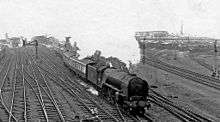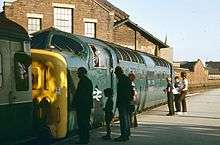Doncaster railway station
Doncaster railway station is on the East Coast Main Line in England, serving the town of Doncaster, South Yorkshire. It is 155 miles 77 chains (251 km) down the line from London King's Cross and is situated between Retford and York on the main line. It is managed by London North Eastern Railway.
| Doncaster | |
|---|---|
 The frontage at Doncaster | |
| Location | |
| Place | Doncaster |
| Local authority | Metropolitan Borough of Doncaster |
| Coordinates | 53.5225°N 1.1395°W |
| Grid reference | SE571032 |
| Operations | |
| Station code | DON |
| Managed by | London North Eastern Railway |
| Number of platforms | 9 (numbered 0–8) |
| DfT category | B |
| Live arrivals/departures, station information and onward connections from National Rail Enquiries | |
| Annual rail passenger usage* | |
| 2014/15 | |
| – Interchange | |
| 2015/16 | |
| – Interchange | |
| 2016/17 | |
| – Interchange | |
| 2017/18 | |
| – Interchange | |
| 2018/19 | |
| – Interchange | |
| Passenger Transport Executive | |
| PTE | South Yorkshire |
| Zone | Doncaster |
| Listed status | |
| Listed feature | Station Booking Hall and Offices |
| Listing grade | Grade II listed |
| Entry number | 1193202[1] |
| Added to list | 25 April 1988 |
| National Rail – UK railway stations | |
| |



It is a major passenger interchange between the main line, Cross Country Route and local services running across the North of England. It is also the point for which London North Eastern Railway services branching off to Leeds diverge from the main route continuing north towards Edinburgh.
History
The railway station was built in 1849 replacing a temporary structure constructed a year earlier.[2] It was rebuilt in its present form in 1938 and has had several slight modifications since that date, most notably in 2006, when the new interchange and connection to Frenchgate Centre opened.
In May 2015, construction commenced on a new Platform 0 to the north-east of the station adjacent to the Frenchgate Centre on the site of the former cattle dock. It is used by terminating Northern Trains services to Hull, Beverley, Bridlington and Scarborough. This allowed these services to operate independently of the East Coast Main Line.[3][4] It is joined to the rest of the station via a fully accessible overbridge.[5]
Station Masters
- G.R.H. Mullins 1849 – 1855[6] (afterwards stationmaster at Boston)
- William Ruxton ca. 1863
- David Greenwood ???? – 1877
- James Bradford 1877 – 1878
- Charles Ratchelous 1878 – 1885
- James L. Rayner 1885 – 1892[7]
- George Bolt ca. 1892 – 1896
- William Henry Lindsey 1896 – 1915
- Thomas Christopher 1915[8] – 1917 (formerly station master at Hatfield)
- Fred Warriner 1917 – 1921[9]
- Mr. Trotter 1921 – 1922[10]
- George Herbert Gregory 1923 – 1933[11]
- E.H. Fowler 1933 – 1937[12]
- Edwin Oliver Wright 1937 – 1940[13]
- R.P. Haw 1940 (acting)
- J.E. Fisher ca. 1951
Platforms
The station has nine platforms on three islands. Platforms 1, 3, 4 and 8 can take through trains. Platforms 2 and 5 are south-facing bays, and 0, 6 and 7 are north facing bays. A first class lounge is available on platform 3A.
Platform 0 is scheduled to take almost exclusively Northern Trains services to and from Hull, Beverley and Bridlington. The brand new platform opened on 12 December 2016.[14]
Platform 1 is used by southbound London North Eastern Railway, Grand Central and Hull Trains services to London King's Cross.
Platform 2 has no scheduled trains.
Platform 3A is used by London North Eastern Railway, Grand Central and Hull Trains services to London King's Cross
Platform 3B is used by Northern Trains services to Sheffield and TransPennine Express services to Manchester / Manchester Airport
Between platforms 3 and 4 are the high speed up and down lines from London
Platform 4 is used by northbound London North Eastern Railway services to York, Newcastle and Edinburgh, Grand Central services to Bradford Interchange, Hull Trains services to Hull, Northern Trains through services to Bridlington and Scarborough and TransPennine Express services to Cleethorpes. Southbound CrossCountry services towards Birmingham New Street also use this platform.
Platform 5 is a bay platform used by East Midlands Railway services to Lincoln and Northern Trains services to Sheffield
Platform 6 is a bay platform used by Northern Trains services to Leeds.
Platform 7 is seldom in public use, but when it is, is used by Northern Trains services to Scunthorpe.
Platform 8 is used by northbound London North Eastern Railway services towards Leeds; and CrossCountry services to Newcastle; and Northern Trains services in both directions – southbound to Sheffield and northbound to Adwick and Scunthorpe. services towards Birmingham New Street also use this platform.
There are presently no ticket barriers in operation at this station; however on race days (at Doncaster Racecourse), manual ticket checks are in operation in the subway.
The station has been recently refurbished in 2006 and is now directly connected to the Frenchgate Centre extension in Doncaster town centre. The station now has a new booking office for tickets and information, three new lifts, refurbished staircases and subway. There is a newsagent and some food outlets. More recently, interactive touch screens have been installed around the station by London North Eastern Railway services to provide information about local attractions, live departures and disruptions and station facilities. As well as this, mobile phone charging points are now available on the concourse, touch screen, self-service ticketing machines have been installed across the concourse and the stairways to the subway have now been divided into two way systems to improve the flow of passengers during peak times.
In a route study by Network Rail it was proposed that new platforms could be built on the western side of the station to meet demand expected in the future.[15]
In March 2019, it was revealed that there were plans, as part of the East Coast improvement programme in Control Period 6, to add an additional platform at Doncaster.[16]
Accidents and incidents
- On 9 August 1947, a passenger train was in a rear-end collision with another due to a signalman's error. 18 people were killed and 188 were injured.[17]
- On 16 March 1951 a derailment occurred south of the station in which 14 passengers were killed and 12 seriously injured.
Services
Seven train operating companies call at Doncaster, which is the highest number of companies in the UK and is also equal in number only to Crewe and Liverpool Lime Street in the UK. Train operators include the following:
CrossCountry
CrossCountry operated hourly services to Newcastle and Reading with one service per day running through to both Edinburgh Waverley and Guildford or Southampton Central.[18] The majority of CrossCountry services at Doncaster use 4-car Voyager DEMUs (Class 220s).
East Midlands Railway
East Midlands Railway offer a limited services to London St Pancras, York and Scarborough. It also operate a local service to Lincoln which occasionally extends to Sleaford and Peterborough.[19]
Grand Central
Grand Central operates services between Bradford Interchange and King's Cross.
Hull Trains
Hull Trains operates services between London King's Cross and Hull or Beverley via Selby.
London North Eastern Railway
London North Eastern Railway offers regular (55 trains per day) direct trains services to London King's Cross, Leeds, Harrogate, York, Newcastle, Edinburgh and Glasgow Central.[20]
Northern Trains
Northern Trains generally offers services from Doncaster to Sheffield, Leeds and Lincoln.
TransPennine Express
TransPennine Express operates services eastbound to Cleethorpes, and westbound to Manchester Airport. TransPennine services operate hourly in each direction generally.[21]
There were plans to add platforms 9 and 10 to cope with Eurostar trains but this project was cancelled when it was decided that Eurostar would not serve Britain outside the South East of England.
In the media
In 1973 the station was featured in the first episode of Whatever Happened to the Likely Lads?, entitled Strangers on a Train, featuring James Bolam and Rodney Bewes. Although it is not stated where the scenes in the station were filmed, signs for Grimsby Town and Scunthorpe are visible in the background.
See also
- Joan Croft Halt railway station (North Doncaster Chord project)
- Doncaster Works – a locomotive works adjacent to the station.
References
- Historic England, "Station Booking Hall and Offices (1193202)", National Heritage List for England, retrieved 29 July 2018
- "Drinking fountain, about 1957". Science and Society Picture Library. Retrieved 29 July 2018.
- "Doncaster to get a Platform 0 in £21m upgrade" The Railway Magazine issue 1371 June 2015 p. 81
- Nigel Harris, ed. (24 June 2015). "Roll up, roll up for Doncaster's Platform 0". Rail. No. 777. p. 15. ISSN 0953-4563.
- "WATCH: Incredible time-lapse footage of new bridge being installed at Doncaster rail station". Doncaster Free Press. 26 April 2016. Retrieved 13 December 2016.
- "Changes in the Situation of Station-master at the Boston Station". Lincolnshire Chronicle. England. 28 September 1855. Retrieved 2 September 2017 – via British Newspaper Archive.
- "Popular GNR Official". Lincolnshire Chronicle. England. 28 September 1855. Retrieved 2 September 2017 – via British Newspaper Archive.
- "Mr Thomas Christopher". Hull Daily Mail. England. 21 April 1915. Retrieved 7 March 2020 – via British Newspaper Archive.
- "Doncaster Station-Master to Be Superintendent". Sheffield Daily Telegraph. England. 19 August 1921. Retrieved 2 September 2017 – via British Newspaper Archive.
- "Official Changes at the GNR". Yorkshire Post and Leeds Intelligencer. England. 4 December 1922. Retrieved 2 September 2017 – via British Newspaper Archive.
- "New Station-Master". Yorkshire Evening Post. England. 15 August 1933. Retrieved 2 September 2017 – via British Newspaper Archive.
- "Former Driffield Station Master Retiring". Driffield Times. England. 13 April 1946. Retrieved 2 September 2017 – via British Newspaper Archive.
- "Former Driffield Station Master Retiring". Driffield Times. England. 13 April 1946. Retrieved 2 September 2017 – via British Newspaper Archive.
- Marshall, Sarah (12 December 2016). "Platform 0 opens at Doncaster train station". The Star. Retrieved 29 July 2018.
- East Coast Main Line Route Study (PDF). Network Rail. 1 June 2018. p. 32.
- p.66
- Hoole, Ken (1982). Trains in Trouble: Vol. 3. Redruth: Atlantic Books. p. 3. ISBN 0-906899-05-2.
- Table 51 National Rail timetable, May 2016
- Table 18 National Rail timetable, May 2016
- Table 26 National Rail timetable, May 2016
- Table 29 National Rail timetable, May 2016
External links
![]()
- Train times and station information for Doncaster railway station from National Rail